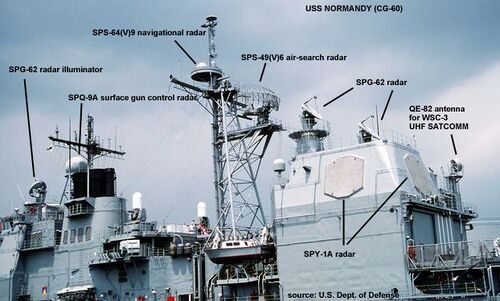SPS-49: Difference between revisions
imported>Howard C. Berkowitz No edit summary |
imported>Howard C. Berkowitz No edit summary |
||
| Line 3: | Line 3: | ||
The '''[[AN-|AN/]]SPS-49''' is a very-long-range, two-dimensional air search radar on [[Ticonderoga-class]] cruisers, but not on [[Burke-class]] destroyers, which provides earlier warning than the three-dimensional [[SPY-1|AN/SPY-1 main radar]]. The two radar systems feed into the [[AEGIS battle management system]] computers. The sensor data can be made available to other platforms via the [[Cooperative Engagement Capability]] to ships equipped with CEC, and to a wider range of recipients through the [[Joint Tactical Information Distribution System]] (JTIDS). | The '''[[AN-|AN/]]SPS-49''' is a very-long-range, two-dimensional air search radar on [[Ticonderoga-class]] cruisers, but not on [[Burke-class]] destroyers, which provides earlier warning than the three-dimensional [[SPY-1|AN/SPY-1 main radar]]. The two radar systems feed into the [[AEGIS battle management system]] computers. The sensor data can be made available to other platforms via the [[Cooperative Engagement Capability]] to ships equipped with CEC, and to a wider range of recipients through the [[Joint Tactical Information Distribution System]] (JTIDS). | ||
It operates in the [[IEEE frequency bands|IEEE L-band]]/NATO C-band, and is mounted higher than the [[SPY-1|AN/SPY-1]] to give it a longer horizon. | In the picture, it is the mechanically scanned antenna on the right of the center mast, below the [[radome]] of the [[SPS-64|AN-SPS-64 navigational radar]]. It operates in the [[IEEE frequency bands|IEEE L-band]]/NATO C-band, and is mounted higher than the [[SPY-1|AN/SPY-1]] to give it a longer horizon. | ||
L-band has longer range than that S-band used by the three-dimensional AN/SPY-1. The radar has a peak power of 360 kilowatts, and extensive [[electronic warfare|electronic counter-countermeasures (ECCM)]] capabilities including [[frequency agility]], variable [[pulse repetition frequency]] and [[sidelobe cancellation]]. | |||
Revision as of 18:19, 12 January 2011

The AN/SPS-49 is a very-long-range, two-dimensional air search radar on Ticonderoga-class cruisers, but not on Burke-class destroyers, which provides earlier warning than the three-dimensional AN/SPY-1 main radar. The two radar systems feed into the AEGIS battle management system computers. The sensor data can be made available to other platforms via the Cooperative Engagement Capability to ships equipped with CEC, and to a wider range of recipients through the Joint Tactical Information Distribution System (JTIDS).
In the picture, it is the mechanically scanned antenna on the right of the center mast, below the radome of the AN-SPS-64 navigational radar. It operates in the IEEE L-band/NATO C-band, and is mounted higher than the AN/SPY-1 to give it a longer horizon.
L-band has longer range than that S-band used by the three-dimensional AN/SPY-1. The radar has a peak power of 360 kilowatts, and extensive electronic counter-countermeasures (ECCM) capabilities including frequency agility, variable pulse repetition frequency and sidelobe cancellation.